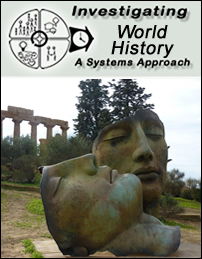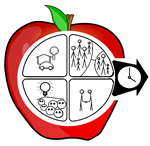Investigating World History: A Systems Approach

Discussions & User Feedback
Listed below are links to pages for this purpose.
- General Discussion
- Paleoanthropology
- Agriculture and the City
- Muddy Rivers
- Mesopotamia
- Ancient Egypt
- Ancient Israelites
- Early India
- Early China
- The Persian Empire
- Phoenicians
- Sparta
- Athens
- Early Rome
- Hellenistic Period
- Roman Culture Change
- Two Religions
- Medieval Society
- Medieval Monastic Life
- Islam's Rise
- Yuan Dynasty China
- Aztec-Spanish Conflict
As with all our course materials, in the spirit of “open source,” these units are offered free of charge to educators for use with their own learners. Detailed specifications
To download a unit , click on its title below. To download illustrations only, click "Images."
, click on its title below. To download illustrations only, click "Images."
Illustrations -- In many parts of the course, color photos and other illustrations are used as data for analysis. We recognize that it may be difficult to supply individual hard copies of color illustrations to each learner. The alternatives are either to give one hard copy (printed on a color printer) to each work team, or else to display the illustrations via a digital projector or smartboard. Separate image files for each part of the course are available—click the associated “Images” link below.
Overview for Teachers and Mentors
Rationale and instructions for using Investigating World History. A discussion of active learning and its benefits, primary sources and complex cognitive processes, and the use of a general systems-based model to guide investigation of reality, past and present.
1: Paleoanthropology (Images)
An introduction to active learning, using photographs and other data from two caves in northern Spain, one occupied during the Neolithic period by ice-age hunter/gatherers, another (quite near the first) with paintings of animals on walls. Learners infer how the people obtained the necessities for living, and possible purposes of objects and images they created.
2: Agriculture and the City (Images)
A focus on organizing knowledge, introducing hierarchical “trees” as organizing tools. The vehicle for skill development is analysis of data from archaeological site “Çatalhöyük,” in present-day Turkey. Learners identify and classify the many kinds of specialized work performed in the community, including those related to early agriculture.
3: Muddy Rivers (Images)
This unit introduces the first of the organizing categories in our Model: “Setting.” A scientific description of six climate zones created by latitude and global air circulation is given, and learners hypothesize about their effects on rivers passing from zone to zone. They test their hypotheses by analyzing Herodotus’ descriptions and other data for Mesopotamia and Egypt.
4: Mesopotamia (Images)
The focus in this unit is on the second organizing category in our Model, “Patterns of Action.” Primary sources from early civilization in Mesopotamia are analyzed to identify action patterns related to work, the economy, religion, farming practices, and other aspects of life in the region. Relationships between setting and action patterns are also investigated.
5. Ancient Egypt (Images)
This unit introduces the third Model category: “Demographics,” using ancient Egypt as the vehicle. Relationships between demographics and the Model categories previously introduced are investigated in some depth, and learners analyze investment of capital by authorities.
6. Ancient Israelites (Images)
The fourth Model category, “Shared Ideas,” is central to the analysis of the primary data in this unit. The Israelites are seen by scholars as originating the linear view of time. Other important shared ideas in the Tanakh—the Hebrew Scriptures—are inferred by learners. The final section traces the effects of the Babylonian exile on Jewish worldview (shared ideas).
7. Early India (Images)
This unit and the next introduce no new analytical concepts, but provide opportunity for learners to apply the four main parts of the Model to new societies. Hence, the units may be used as evaluation instruments to determine learners’ levels of understanding of the processes and concepts used to this point in the course of study.
8. Early China (Images)
This unit explores relationships between setting and shared ideas, and conflicts between Confucian and Legalist ideologies in China in the 4th through the 2nd century BCE. As with the “Early India” unit, this unit may be used for evaluation of learners’ analytical skills.
9. The Persian Empire (Images)
This unit introduces the overarching Model component “Systemic Relationships,” along with simple block-and-arrow diagrams to show possible systemic relationships between patterns of action within nomadic life and shared ideas and patterns of action contributing to successful warfare.
Y2. Phoenicians (Images)
Those using these world history units may choose to spread them over two years of study. If so, this supplementary unit may be used as a second year introduction. The focus is on Model reintroduction.
10. Sparta (Images)
Of all the shared patterns of action within a society, probably the most important are those associated with “socialization”—shaping the young to perpetuate and transmit the society’s important ideas, values and individual attributes. The systemic effects of socialization can best be seen in a society that differs from the learners' own, and Sparta is startlingly different.
11. Athens (Images)
Other shared patterns of action of great systemic importance are those related to making and carrying out major decisions for the society. Decision-making patterns—the political subsystem—are the focus of this unit. Learners investigate the development of democracy in Athens, and evaluate its effects.
12. Early Rome (Images)
Early in the 5th century BCE conflict between patricians and plebeians began in Rome over the issue of debt slavery. This unit explores autonomy and the historically-significant reactions that occur when it is thwarted.
13. Hellenistic Period (Images)
This unit explores systemic relationships that characterize dominant Greek culture related to Alexander the Great and the period that followed his death.
14. Roman Culture Change (Images)
Cumulative causation is a major systemic driver of historical change. This unit analyzes profound second century BCE and third century CE changes in the Roman Empire.
15: Two Religions (Images)
The religious action patterns and shared ideas in the Roman Empire changed radically with the development and growth of Christianity. This unit investigates systemic relationships associated with the changes.
16: Medieval Society (Images)
In this unit learners create their own questions and use them to investigate the causes and consequences of systemic changes associated with the evolution of medieval society.
17: Medieval Monastic Life (Images)
Every society and subgroup carefully distinguishes between "insiders" and "outsiders." These groups set up and maintain mental, behavioral, and often physical boundaries to separate the two. Medieval monasteries vividly demonstrate these principles.
18: Islam's Rise (Images)
Beginning early in the seventh century in Arabia, Islam quickly spread across southern Asia, northern Africa, then into Iberia. This unit examines rapid system change, its historical causes and consequences.
19: Yuan Dynasty China (Images)
Civilization-building systems that benefit the public, and their relationships to government, are investigated here, using Marco Polo's descriptions of Chinese Cities in the late 13th century.
20: Aztec-Spanish Conflict (Images)
When dissimilar societies meet, differences may lead to conflict. Learners analyze a variety of confrontations to identify aroused emotions and the underlying differences in ideas and action patterns.
